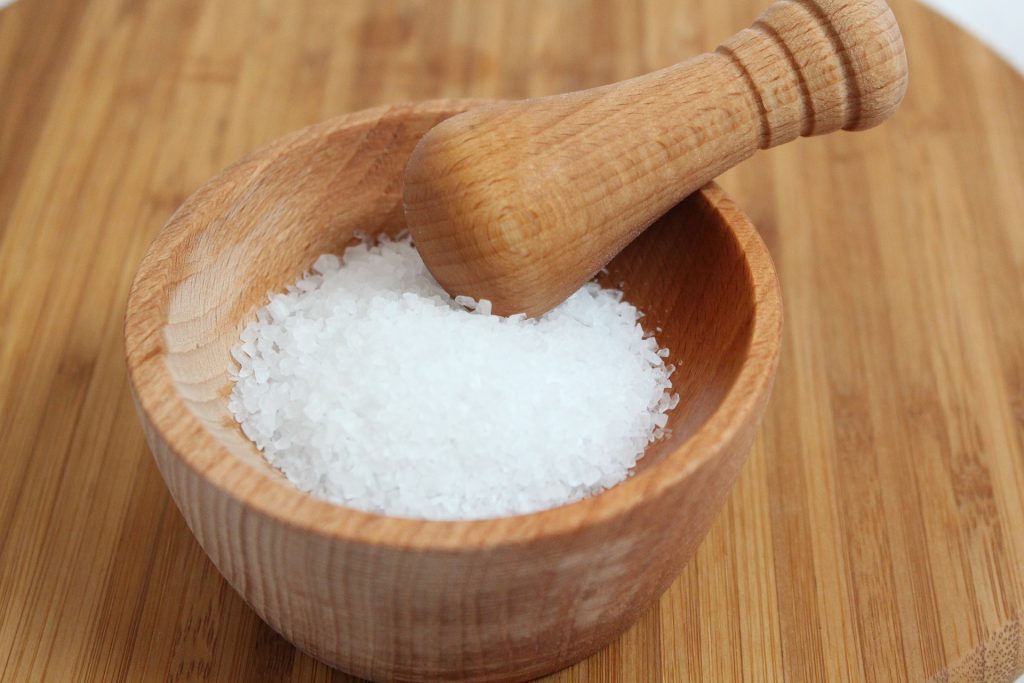
Let’s have a look at a taste so peculiar, because of its important and, at least apparently, conflicting functions: indeed, it can soften and wet, or dry: the salty (or saline) taste.
The salty taste is clearly due to the presence of salts within the plant, in such concentration that their presence can be perceived by taste. Obviously, the quantity and kind of salts vary from species to species, because each species tends to absorb preferentially some specific chemical elements and to accumulate them to specific parts of the plant (the content of each chemical element in leaves, roots, stems varies). Certainly, also the “kind” of salty taste varies according to the salts preferentially accumulated by each plant. We can distinguish among:
- a salty taste strictly speaking (that we call true salty), typically due to the accumulation of sodium chloride[2]; it’s the taste of glasswort (Salicornia), chickweed (Stellaria spp.), mallow, seaweeds;
- a kind of salty taste that is slightly “bitterish”, earthen[3], and that confers a certain crispness to the plant (a taste that we call earthen salty), probably due to the preponderance of salts other than sodium chloride[4]; it’s the taste of spinach and nettle.
The plants can also contain other salts that confer other peculiar tastes and properties. A moderate concentration of iron salts can give the plant a slightly metallic taste (that we call metallic salty or simply metallic), that is usual weak but persistent. We can perceive this taste, for instance, chewing carefully the leaves of Ceterach officinarum and chickweed (Stellaria spp.). The plants rich in iron (Ceterach, chickweed, nettle, yellow dock) are typically able to “reduce” the spleen (that is to reduce splenic enlargement), and to act as strong regulators of Melancholy “metabolism”, so reducing the so called “bad constructions” (i.e., excessive, defective and misplaced “indurations”), and supplementing the correct Melancholy, especially with regard to the “building” of Blood. They treat anemia and stimulate the bone marrow; they cannot be generally considered true Blood tonics (for instance, according to TCM), unless they are also able to augment body fluids[5], or they are taken together with drugs that augment body fluids (like honey or blackstrap molasses[6]).
Plants with a high silicon content have very interesting properties, too. First, they are able to supplement (or tonify) the correct Melancholy, optimize assimilation and “fixation “of calcium, and to nourish the bone, connective, and nervous tissues and the vitreous humor of the eye. According to some authors (see, for instance, [Tierra] and [Wood2]), silicon-rich plants stimulate the depuration of tissues, since they are able to push toxins toward the outside or surface of the body[7]. Examples of such plants are oat (Avena spp.), horsetail (Equisetum spp.), couch grass (Elytrigia repens or Agropyron repens) and prostrate knotweed (Polygonum aviculare). Silicon-containing plants have not usually a specific taste of their own; they often, but not necessarily always, taste earthen, so having also the properties of this taste. Silicon-rich herbaceous plants often can be recognized for being provided with more or less “hard” and rather rigid parts, that appear almost “mineral” to the touch and taste[8] (let’s think, for instance, about the consistency of the stalks of cereal plants or of the horsetail sterile stems). Virtually we can assign them a taste that we can call siliceous.
When the various traditional disciplines speak of salty taste, they mostly refer to the true salty or, at most, to the earthen salty. Here we follow the same convention, so referring to the salty (without further specifications) taste as both the true salty and the earthen salty tastes. Metallic and siliceous salty tastes will always be named explicitly.
The salty taste dampens, softens and thins humors (penetrates deeply), and it is evacuating (frees the bowels). So, it wets and softens tissues; it wets and softens the thickened Phlegm too (and so the more or less hardened “masses”, or lumps, located within the tissues[9]) and the bowel content, preparing them for elimination. Even if the salty herbs are, at first, only wetting and softening, their action can be pushed up to the point that they actively promote the elimination of excess humors and/or the evacuation, so obtaining a decidedly drying final effect. In excessive amounts, salty dries the fluids and damages the tissues in general, and especially the bones[10]. Salty gives the plants a fresh taste, probably due to its ability to draw and “vehiculate” water, that is cold and damp.
According to the Five Movements systematic correspondence of TCM, the salty taste is associated to the Kidneys. According to the taste/action association, it dissolves lumps and resolves constipation, removes moisture and Phlegm, and softens hardness (actions that fall under the heading of “resolving therapies”) [ITMOnline].
Sources
[ITMOnline] http://www.itmonline.org/articles/taste_action/taste_action_herbs.htm
[Tierra] Michael Tierra, “Planetary Herbology”, Lotus Press Santa Fe (1988)
[Wood2] Matthew Wood, “The Earthwise Herbal – A Complete Guide to New World Medicinal Plants”, North Atlantic Books (2009)
[1] Some plants rich in mineral salts (e.g., horsetail) increae the “constructions”, other plants are best suited to resolve stagnation.
[2] David Winston calls this taste “true salt” and says it has a Cold/Dry nature; Matthew Wood calls it “salty” [Wood2].
[3] This taste recalls that of magnesium chloride, MgCl2.
[4] David Winston calls this taste “mineral salt” and says it has a Cool/Dry nature; Matthew Wood calls it “earthen” [Wood2].
[5] Ceterach is diuretic, nettle and yellow dock are alterative, chickweed is phlegmagogue.
[6] Blackstrap molasses has a perceivable metallic taste.
[7] Homeopathic provings showed that dynamized silica promotes the outward release of pus and foreign materials [Wood2].
[8] Here, we should speak of a tactile sensation in the mouth, rather than a real taste.
[9] The extent of hardening is also connected to the content of perverted Melancholy: the hardest the masses, the largest the Melancholy content.
[10] According to the western medicine, an excessive sodium intake contributes to calcium depletion.



